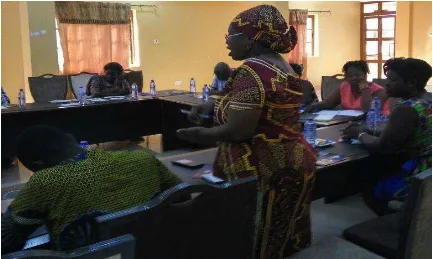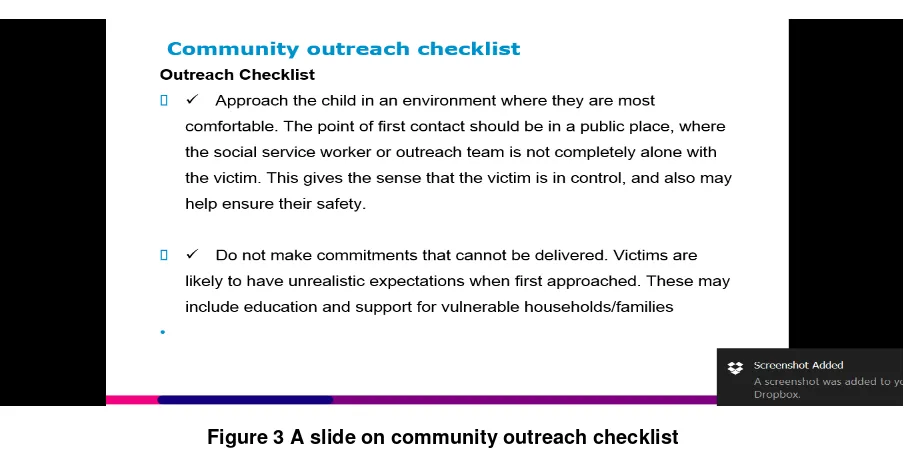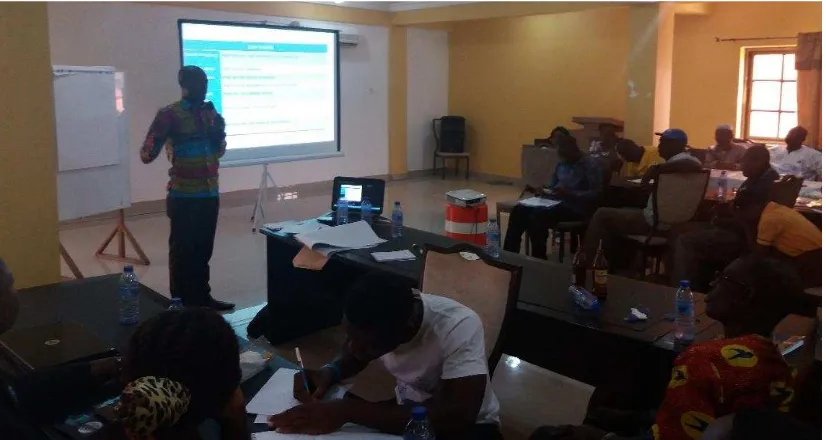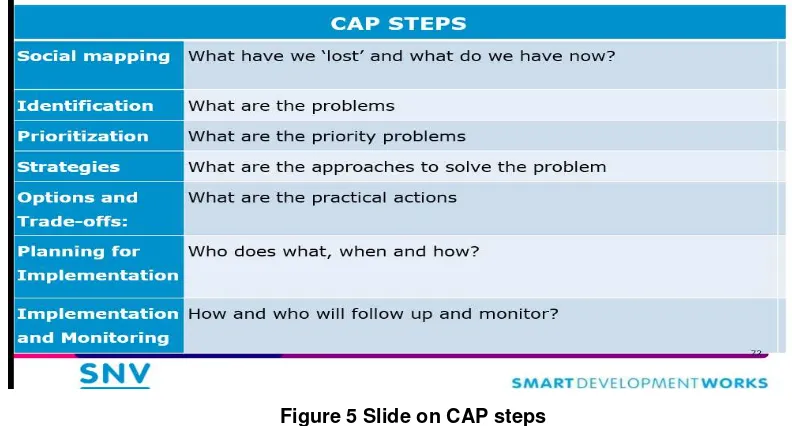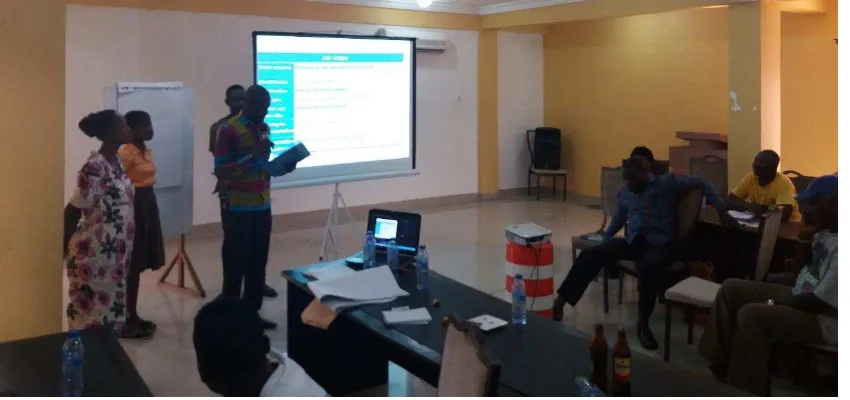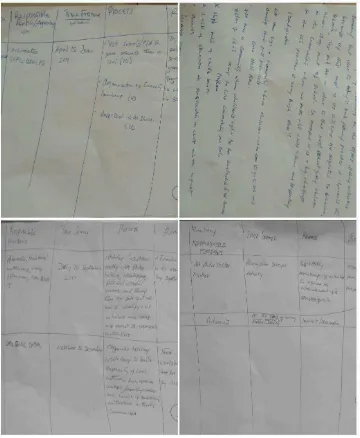SUSTAINABLE FISHERIES
MANAGEMENT PROJECT (SFMP)
Training Report on Anti-CLaT
Strategies, Referral Process and
Community Action Planning
This publication is available electronically in the following locations: The Coastal Resources Center
http://www.crc.uri.edu/projects_page/ghanasfmp/ Ghanalinks.org
https://ghanalinks.org/elibrary search term: SFMP USAID Development Clearing House
https://dec.usaid.gov/dec/content/search.aspx search term: Ghana SFMP
For more information on the Ghana Sustainable Fisheries Management Project, contact:
USAID/Ghana Sustainable Fisheries Management Project Coastal Resources Center
Graduate School of Oceanography University of Rhode Island
220 South Ferry Rd.
Narragansett, RI 02882 USA
Tel: 401-874-6224 Fax: 401-874-6920 Email: [email protected]
Citation: Adeborna D. (2017). Training Report on Anti-CLaT Strategies, Referral Process
and Community Action Planning. The USAID/Ghana Sustainable Fisheries Management Project (SFMP). Narragansett, RI: Coastal Resources Center, Graduate School of
Oceanography, University of Rhode Island and Netherlands Development Organisation. GH2014_POL101_SNV 19 pp.
Authority/Disclaimer:
Prepared for USAID/Ghana under Cooperative Agreement (AID-641-A-15-00001), awarded on October 22, 2014 to the University of Rhode Island, and entitled the USAID/Ghana Sustainable Fisheries Management Project (SFMP).
This document is made possible by the support of the American People through the United States Agency for International Development (USAID). The views expressed and opinions contained in this report are those of the SFMP team and are not intended as statements of policy of either USAID or the cooperating organizations. As such, the contents of this report are the sole responsibility of the SFMP team and do not necessarily reflect the views of USAID or the United States Government.
Detailed Partner Contact Information:
USAID/Ghana Sustainable Fisheries Management Project (SFMP) 10 Obodai St., Mempeasem, East Legon, Accra, Ghana
Telephone: +233 0302 542497 Fax: +233 0302 542498 Maurice Knight Chief of Party [email protected]
Kofi Agbogah Senior Fisheries Advisor [email protected] Nii Odenkey Abbey Communications Officer [email protected]
Bakari Nyari Monitoring and Evaluation Specialist [email protected] Brian Crawford Project Manager, CRC [email protected]
Ellis Ekekpi USAID AOR (acting) [email protected]
For additional information on partner activities:
CRC/URI: http://www.crc.uri.edu CEWEFIA: http://cewefia.weebly.com/
DAA: http://womenthrive.org/development-action-association-daa Friends of the Nation: http://www.fonghana.org
Hen Mpoano: http://www.henmpoano.org
ACRONYMS
AAK Abura Asebu Kwaman Kesse District Assembly BCC Behavioural Change Communication
CAP Community Action Plan
CEWEFIA Central and Western Region Fish Improvement Association CLaT Child Labour and Trafficking
CCPC Community Child Protection Committee DAA Development Action Association
DA District Assembly
DSW Department of social Welfare
TABLE OF CONTENTS
SOME OF THE KEY STRATEGIES DISCUSSED INCLUDE ... 3
2.1.1 Community Awareness and Behaviour Change Communication Strategies ... 3
2.2 Identification and referral ... 4
2.2.1 Who can identify ... 4
2.2.2 Victim ... 4
2.2.3 Law enforcement ... 5
2.2.4 Social service worker ... 5
3.0 The referral process... 6
3.1 Community Outreach ... 6
3.1.1 Outreach Strategies ... 7
3.1.2 The outreach check list ... 7
4.0 DEVELOPING COMMUNITY ACTION PLANS (CAPs) ... 8
4.1 The CAP process... 9
4.2 Group Exercise... 10
5.0 CONCLUSION ... 12
LIST OF FIGURES
Figure 1 Key roles of a social worker ... 5
Figure 2 AAK District Social Worker explaining community outreach and the DSW referral process... 7
Figure 3 A slide on community outreach checklist ... 8
Figure 4 Mr. Paintsil of AAK district explaining the DAs planning process ... 9
Figure 5 Slide on CAP steps ... 10
Figure 6 KEEA District Assembly Social Service Committee representative explaining the Assembly funding priorities areas ... 10
Figure 7 Community group work on developing CAP ... 11
Figure 8 Participant presenting practice CAP developed by the Elmina group ... 11
ACKNOWLEDGEMENT
I would like to acknowledge CEWEFIA staff and DAA for their remarkable support in organising participants for the training and also with translations during the two-day training workshop. A big thank you to all the participants who took time away from their busy schedules to attend this training workshop and strengthen their skills to enable them make a difference in their communities.
EXECUTIVE SUMMARY
It is estimated that there are over 2.7 million child laborers in Ghana and that the largest employers of child labor in Ghana are in the Fishing, Cocoa and Artisanal Mining sectors. Child Labor and Trafficking (CLaT) victims in the fisheries sector are exposed to various degrees of life-threatening dangers. The U.S. Government 2016 Trafficking in Persons Report classified Ghana as a Tier 2 Watch List country for the second year in a row. This means that the US Dept. of State has concluded that the Ghana government does not fully meet the minimum standards for the elimination of trafficking in persons. This classification has varied implications for Ghana; including likely cuts in US development assistance, and requires both national and local level efforts aimed at reducing child labor and trafficking in the long term to avoid this sanction.
1.0 INTRODUCTION
The Sustainable Fisheries Management Project SFMP, with the support from implementing partners, is currently implementing a number of strategies aimed at reducing Child Labour and Trafficking (CLaT) in the fisheries sector through behaviour change communications and livelihood interventions that targets adult caretakers (parents, guardians, etc.) who are the key perpetrators in CLaT cases as a result of poverty or lack of knowledge and understanding of the damages of CLaT on children.
One of the strategies adopted in Year Three of the Project is to support Community Child Protection Committees to function effectively in advocacy, reduction, and elimination of CLaT in source communities.
In order to implement this strategy, the Netherlands Development Organisation (SNV), the lead agency for the CLaT component of the project, was assigned to provide a capacity building training workshop on the development of Community Action Plans, CLaT
prevention strategies stated in the anti-CLaT policy in Fisheries Strategy developed under the SFMP in 2016 and the use of the systematic referral mechanism and protocols developed under the Child Protection Compacts.
This training workshop was designed for Community Child Protection Committee (CCPC) members from Moree and Elmina, under the Central and Western Fishmongers Improvement Association (CEWEFIA) Local Implementing Partners, District Assemblies, traditional authorities, and anti-CLaT advocates.
1.1 Workshop objective
The objectives of this training workshop were to:
Build the capacity of implementing partners, to build the capacity of the Community Child Protection Committees (CCPCs), and anti-CLaT advocates on anti-Child Labor and Trafficking Strategies.
Build the capacity of implementing partners, to build the capacity of the Community Child Protection Committees (CCPCs), and anti-CLaT advocates on the use of the systematic referral mechanism and protocols developed under the Child Protection Compacts.
Build the capacity of implementing partners, to build the capacity of the Community Child Protection Committees (CCPCs), and anti-CLaT advocates on Development of Community Action Plans.
1.2 The key outcomes
The key outcomes of this workshop was to develop the capacity of the participants on anti-CLaT strategies, as published in the anti-anti-CLaT policy in fisheries Strategy developed under the SFMP in 2016. Also, participants were trained on the use of the systematic referral mechanisms and protocols developed under the Child Protection Compacts. (IOM, 2016). Finally, the training workshop sought to train participants on the development of Community Action Plans (CAPs).
1.3 Training method
Power point presentation was the main method used to deliver the training. Opportunities were given for several informal group and individual discussions, video/documentary
1.3.1 Venue
The training took place on 2nd and 3rd February 2017 at Samrit Hotel in Cape Coast and was facilitated by Dickson Adeborna.
1.3.2 Participants
The training workshop was attended by a total of 48 participants of which 17 were female and 29 were male. Participants included staff from the SFMP implementing partner Central and Western Fishmongers Improvement Association (CEWEFIA), Community Child
Protection Committee (CCPC) members from Moree and Elmina, advocates from Apam and Winneba, Social workers, District Assembly planning officers, Community opinion leaders and chief fishermen.
2.0 KEY DEFINITIONS
In an attempt to ensure that participants had a general understanding of the subject, the training started with an introduction by the facilitator with the definition of Human Trafficking under the 2000 UN Palermo protocol and the 2005 Human Trafficking Act of Ghana. Particular reference was made to people under age 18, i.e. Children.
There were also discussions of common terminologies and phrases on human trafficking such as exploitation, coercion, forced labour, worst forms of child labour, debt bondage, slavery, vulnerability, social worker, police officer, civil society organisation etc.
Finally, the USAID-SFMP sponsored documentary on CLaT was played and discussed to bring participants closer to the issues.
2.1 Prevention strategies
With respect to the demographics of the participants and the expected outcomes, the training workshop highlighted and discussed strategies and interventions to prevent children from being engaged in child labour or trafficked into fisheries activities. Broad areas covered were addressing migration issues, elimination of harmful cultural practices through culturally sensitive and appropriate interventions, i.e. (fostering) adopting appropriate laws, instituting stringent measures, guidelines and regulations and instituting after-school programs.
SOME OF THE KEY STRATEGIES DISCUSSED INCLUDE:
Developing programs that provide income-generating opportunities for deprived families and communities in other income generating activities to reduce their vulnerability to child labour and child trafficking.
Undertake targeted public education and sensitization on the laws that prohibit child labour and child trafficking (including the dangers of CLaT).
Engage in media awareness and policy advocacy on policies and laws that prohibit child labour and child trafficking.
Consciously sensitize families and/or households to see investment in children's education as providing them with a future and helping society to derive the best out of its citizens.
wide discourse and actions to enhance changes in behaviour towards children and survivors by parents and other traffickers and users of children for work.
Specific strategies discussed under BCC were:
Designing effective community-led communication programs to protect children. This highlighted approaches to communicate key messages which may include community drama, storytelling, posters, songs, videos, school visits, and radio discussions.
Stakeholder engagement was also highlighted. It was noted that this will help to know, believe, and feel the need for them to begin to think about changing behaviours and attitudes towards children and promote children's rights and welfare.
Mobilising communities to design and implement programs on the effects of child labour and child trafficking. (Community Action Plans)
Conducting child labour and child trafficking community campaign meetings using different techniques such as stickers, community forums, theatre for change, and community radios.
Promoting children's rights and responsibilities (and the rights of boys and girls) and informing communities of the importance of preserving these.
2.2 Identification and referral
Under this subject, discussions highlighted that trafficking of human beings constitutes a serious infringement of human rights. Therefore, identifying trafficked children is vital to ensuring that victims are granted access to comprehensive protection and support services. Identification is the process of determining the status of a person as a victim of trafficking, and screening is the process by which trained social service workers learn more about the victims of trafficking, their medium and long-term needs.
The training ensured that participants are aware that if a victim is not identified as such, he or she could be left without appropriate support in order to recover from the trafficking ordeal and this is to the detriment of the trafficked victim. Hence emphasis placed on the vital first step to providing victim protection is determining whether an individual is in fact a victim of human trafficking. Without access to protection and support services, trafficked persons might not have sufficient confidence and security to co-operate with law enforcement officials in criminal investigations. Without evidence and testimony from trafficked persons, it is difficult to prosecute traffickers.
In line with the above, there were discussions on terminologies and phrases as published in the identification and referral protocols developed under the Child Protection Compact.
2.2.1 Who can identify
This subject highlighted to participants that any person with “reasonable grounds to believe that another person is a trafficked person” should report that belief to the police. Trained and authorised professionals may also conduct outreach but should inform the police of any human trafficking cases.
2.2.2 Victim
The training also highlighted that victims play a central role during the identification and screening process. A victim can provide critical information to social service workers or law enforcement officials which can be used for purposes of protection, prevention, and
prosecution. To successfully cooperate with a victim, it is important to recognize their basic human rights, including the right information, confidentiality, protection, and
non-discrimination. If the victim is a child, authorities, parents, and guardians must act in the best interest of the child and respect the views of the child.
A victim of trafficking may have a mind-set of fear, distrust, denial, and conflicting loyalties. Victims of trafficking are often fearful of being jailed and may distrust authority figures, particularly law enforcement and government officials. Similarly, traffickers may convince trafficking victims that the police will jail the victim if they file a complaint. Victims of either sex or labour trafficking fear that if they escape their exploitation and initiate investigations against their trafficker, the trafficker and his/her associates will harm the victim or the victim’s family members.
2.2.3 Law enforcement
Law enforcement agencies are key partners in the identification and referral of victims and the prevention of trafficking through proactive deterrence. Law enforcement also has a
prominent role in conducting evidence-based investigations, identifying suspects, and making arrests. Law enforcement officials will receive tips and complaints from victims and
witnesses, and are initially responsible for taking a statement, provide safety and medical referrals when necessary, and register the case. Law enforcement officials are also
responsible for leading rescue operations, arresting perpetrators, and pursuing convictions.
2.2.4 Social service worker
This is a person who is a member of the Department of Social Welfare or representing a non-governmental organization trained in providing social services.
3.0 THE REFERRAL PROCESS
Participants were trained that any person with information about trafficking individuals should inform an authority - a police officer, an immigration officer, a customs officer, a social welfare worker, a healthcare provider, a teacher, a district labour officer, an NGO worker, embassy or consulate staff or a community leader. This person of authority should file a complaint with the police immediately.
Also, those who manage public transportation services (i.e. bus terminals, lorry stations, ships) and operate public vehicles or airplanes must take reasonable steps to obtain the travel details of each passenger. Any suspicious circumstances (i.e. large group of children traveling with one adult) should be reported to the police immediately for further investigation, and to a social service worker for victim assistance.
3.1 Community Outreach
With CCPC members and community advocates forming the majority of the participants for this training workshop, this topic generated a lot of interest and discussion.
It was evident at the end of discussions that almost every participant clearly established that outreach among communities can lead to the identification of victims of trafficking. The sharing of practical experiences by participants highlighted that outreach involves building trust, providing information and establishing positive relations among community members. Outreach strategies vary and differ based on the specific community and circumstances. Some outreach strategies, like community sensitization, awareness durbars and sports activities involve actively targeting certain groups identified as vulnerable to human trafficking.
Figure 2 Abura Asebu Kwaman Kesse District Assembly (AAK) District Social Worker explaining community outreach and the DSW referral process
3.1.1 Outreach Strategies
It was highlighted during the training that depending on the role or function, different reinforcing strategies may be used to actively identify child victims of trafficking. For
example, Community Child Protection Committees (CCPCs) can search for children working in exploitative conditions within their own communities. Also, community labour officers can search for child workers in both formal and informal sectors, including fishing
communities, farms, quarries, mines, construction sites and plantations. In addition, NGOs implementing projects on child protection or in communities can assist by screening for potential child victims of trafficking. Law enforcement officers can search suspected fishing communities; or community leaders can meet to share information and coordinate action, including the development of community referral pathways for responding to the various needs of child victims of trafficking, once identified.
3.1.2 The outreach check list
Figure 3 A slide on community outreach checklist
4.0 DEVELOPING COMMUNITY ACTION PLANS (CAPS)
In line with the SFMP strategy aimed at supporting Community Child Protection Committees (CCPCs) to function effectively in advocacy, reduction, and elimination of CLaT in source communities, community action planning has been one of the key objectives of the training workshop.
The training aimed at enhancing the capacity of local Implementing Partners, District Assemblies, Community Child Protection Committees, and anti-CLaT advocates on Child Labour and Trafficking to understand Community Action Plans and be able to develop them in their communities to protect children and vulnerable people.
In view of this, participants were introduced to the topic and the processes involved in developing CAPs. They were made aware that CAPs can include various issues identified by the community that need to be confronted. However, the focus of this training was on child protection action planning, with reference to certain issues such as poverty, vulnerability and livelihood support.
In spite of this, participants were encouraged to highlight all areas needed to ensure that a holistic and realistic Community Action Plan is developed to protect children.
The key point to highlight in this report is the processes involved in developing the CAP. In this section, a participant from the Abura Asebu Kwaman Kesse District Assembly
(AAKKDA) and the District Assembly (DA) planning officer, Mr Ernest Paintsil took participants through the various DA planning processes and the process communities need to follow to ensure their needs are included in the general district four-year plan. Mr Paintsil highlighted the timely nature of the training workshop as the DA will start the development of the new four-year plan by March 2017, for the 2018-2021 planning session. He also highlighted that for the CAP to be included in the DA plan, it has to be owned by the
Figure 4 Mr. Paintsil of AAK district explaining the DAs planning process
4.1 The CAP process
As shown in the picture below, the training workshop highlighted the various steps involved in the developing of CAPs. Participants discussed every stage of the process and the existing challenges in their communities. One key challenge highlighted in the discussions is funding from the District Assembly. The discussions concluded that there is the need to involve all the community stakeholders for funding, such as the premix fuel associations. Mr Adeborna at this point emphasised that mobilising the community for an action plan must begin with identifying key stakeholders who want to partner with the community.
The discussions on the CAP process gave every participant, in particular the social workers, district assembly members and the Opinion Leaders the opportunity to share their experiences and what will be required of the participants, community leaders and the CCPCs in the
Figure 5 Slide on CAP steps
Figure 6 Komenda/Edina/Eguafo/Abirem Municipality (KEEA) District Assembly Social Service Committee representative explaining the Assembly funding priorities areas
4.2 Group Exercise
In an attempt to ensure a practical training workshop, participants were split into 3 groups, based on the communities they were representing, to develop a sample CAP based on the lessons learnt from the training workshop. The three main communities involved in the exercise were Moree, Elmina, and Winneba.
Figure 7 Community group work on developing CAP
Figure 8 Participant presenting practice CAP developed by the Elmina group
Figure 9 Practice CAP developed by a group of participants
This practice CAP developed by a group of participants demonstrates that the participants have a clear understanding of what a CAP is and the processes or stages involved. They also demonstrated the understanding of some strategies and monitoring systems needed to reduce CLaT in their communities. It is important that this understanding is followed up at the community level by CEWEFIA, DAA and the District representatives to ensure that a complete and active CAP is developed in various communities.
5.0 CONCLUSION
This was a successful workshop with a high level of engagement from the participants. The level of discussions, passion, and experience demonstrated participant’s clear awareness of the issues of child labour and child trafficking in their communities. However, it was apparent that working together as a group of people or as a community was a challenge to carving out strategies and interventions to curb the issues in the communities
engaging in effective outreach work and developing community action plans with clear strategies and monitoring systems. The level of understanding of the processes and stages demonstrated shows clearly that individual participants would like to see a change in their communities. It is necessary that they get the support from implementing partners,
CEWEFIA and DAA and their district assemblies to guide the process. Working closely with every stakeholder in the communities is necessary to challenge the district assemblies to include anti-CLaT strategies in their plans.
